 Today’s halfway houses and snack bars are designed to give golfers the same service, comfort and quality as clubs’ other dining spots.
Today’s halfway houses and snack bars are designed to give golfers the same service, comfort and quality as clubs’ other dining spots.
Halfway houses and snack bars on club and resort golf courses have evolved to become more than just a quick stop at the turn. Snack “huts” and “shacks” that are about as fancy as their names imply are quickly disappearing, and well-appointed, more comfortable facilities are taking their place. While the primary reason for having a halfway house—as a place for golfers to reenergize—remains the same, a renewed focus on the quality, comfort and service now offered by these recharging stations is enhancing not only the time spent playing golf, but the overall club experience as well.
“A halfway house is an extension of the standards for facilities and service that we hold high throughout the entire property,” says Melinda Graziano, Membership Director at Forsyth Country Club in Winston-Salem, N.C. “We want to offer consistent experiences to our members when they’re here, regardless of the areas they’re visiting.”
SUMMING IT UP
|
Halfway houses, in fact, are fast becoming venues for both golfers and non-golfers to enjoy, as properties discover that fine-tuning the look, feel and menus of these facilities can be another great way to appeal to all of the men, women and families among their memberships.
Familiar and Inviting Looks
The design of the halfway house at Green Gables Country Club in Denver, Colo., revolves around bringing the outdoor experience from the course indoors. High ceilings and oversized windows that provide 180-degree panoramic views of the course and surrounding landscape make the halfway house an extension of Green Gables’ picturesque course.
Because of this setting, the club’s 1,900-sq. ft. halfway house serves as more than just a quick on-course stop; instead, it stands as an additional dining option. Built in a similar architectural style as the rest of the clubhouse, its white, brick-and-wood exterior and hunter-green awnings over the interior and service windows (see photo, opposite page, top left) suggest a lively, casual atmosphere. “The design brings the outside experience in,” says Peter Eckel, Clubhouse Manager.
Inside, the halfway house offers a green-tiled room decorated in complementary mustard and hunter-green tones. The front of the halfway house is an open dining space, with cream- and stone-toned tables and hunter-green and mustard mesh chairs. A walk-up service window is located toward the back of the halfway house, with the kitchen behind the service window.
Large double-doors then lead to two cement patios at the south and north ends of the building. With six wrought-iron tables and hunter-green umbrellas on each patio, the outdoor seating area is a favorite place for members to enjoy their meals. Planter boxes decorate the front of the halfway house, as tulips and seasonal flowers bloom around the patios, to further complement the natural beauty of the grounds.
With a “small but complete” kitchen setup, the halfway house has a full bar and provides an extensive menu, with everything from staples such as hamburgers and hot dogs to more health-conscious fare like salads and wraps. The menu, along with the halfway house’s convenient location between holes nine and 10 (and only about 75 feet from the main clubhouse), has helped make it a dining destination in its own right. Golfers enjoy the halfway house before, during and after their games, while non-golfing members and guests frequent the facility when they are looking for a more casual dining option.
“There are some halfway-house establishments that are meant to have limited service and a limited product mix, but ours is much more extensive,” says Eckel. “It is an additional dining facility for us, and a convenient location that enhances the [golfing and club dining] experience.”
Green Gables also uses the halfway house for smaller special events, including tournament breakfasts, awards luncheons and even wine tastings. Most of the events held in the halfway house have some kind of golf focus, but the club will decorate the space based on the needs of a particular event. With the large dining area, Green Gables is able to bring in additional furnishings and even set up portable bars for bigger events.
Seeing the Light
Halfway houses that are designed as extensions of the clubhouse, like the one at Green Gables, tend to have wider appeal. The white halfway house with a black roof at Forsyth CC, called the Field House (see photos, opposite page and pg. 26, top right), blends with the property’s traditional, Georgian-styled, white-brick buildings that all have black slate or asphalt roofs. “The design mimics our main clubhouse and pro shops on the property,” says Graziano. “It is almost a ‘mini’ version of the clubhouse, yet it has a front similar to our golf pro shop.”
Inside, the Field House is decorated in soft greens and bright whites (see photo, pg. 26, top left). Paintings of the club’s golf course line the walls, while recessed lighting and large windows keep the space bright and highlight the picturesque views of the course and grounds. “It is very light and airy in there,” says Lee Smith, General Manager.
Inside, the Field House has three white, acrylic tables and chairs set up in a dining area. Outside, a cement patio holds two wrought-iron tables and chairs, along with umbrellas to provide shade. The patio has plants around the perimeter and overlooks the 10th tee, the short-game facility and the teaching green.
The Field House has entrances on both the north and south ends of the building, along with a walk-up window on the side for golfers approaching from the 10th tee box. It is located about 250-300 feet from the pool area, making it a popular venue for pool-goers as well.
Non-golfing members often walk or drive a golf cart over to the Field House when they want a casual lunch. “It is a warm, welcoming and low-key environment,” says Smith. “It is a little more intimate than the pool snack bar, and it has a different feel to it. If you want to get away from the small kids at the pool and have a quiet lunch, the Field House is a good place for that.”
A Cut Above
More laid-back and personalized décor within a halfway house can add charm to an intimate space. The new halfway house at Corning (N.Y.) Country Club was actually designed and built by Food & Beverage Manager Troy Goho and Executive Chef Brud Holland. Both men are skilled carpenters who wanted to use their skills to give the existing facility a facelift. Their vision for the space was to improve the ambiance, make it more inviting, and expand the menu.
“They wanted to create a nice space that reflected the entire experience of the club,” says Michael Sweet, General Manager. “They did all the work themselves as far as the wood paneling, the painting, the countertops and the new lighting.”
Goho and Holland updated the rundown, green-toned facility by incorporating rich, cherry-stained wood paneling throughout the space. The seating area that accommodates about eight people is surrounded by windows, to brighten and open up the facility. In the kitchen, they installed a new refrigerator, a deli setup to provide fresh-made sandwiches, and a draft-beer system. The kitchen and dining areas are separated by a creative half-wall that is made of irons and shafts from used golf clubs.
As they worked on the space, Goho and Holland stumbled upon wooden panels that had the names of former club champions hand-painted on them. These panels had formerly been displayed in the clubhouse prior to a renovation in 2000. Goho and Holland pulled the panels out of storage and hung them on the walls within the halfway house, to highlight the club’s rich golf history. “That was really interesting to our members,” says Sweet. “It brought back a lot of memories.”
A 55-inch LCD television with a split-screen function now hangs within the space. Half of the screen is tuned to the Weather Channel, and the other half acts as a digital menu board. The TV was also used recently by a group hosting a movie night at the halfway house. “A local church wanted a space to watch a DVD presentation, so we set up the halfway house for them and they catered some food through us,” says Sweet. “It worked out well, and they loved the space.”
Members Know Best
Halfway houses that incorporate the vision and/or talents of members are often most successful at being a facility tailored to member needs. For example, the new halfway house at The Golf Club of Dallas (Texas) was designed, built and paid for by one of the club’s members. Having a member take the reins on the project gave the spot a distinctive look and appeal all its own. For inspiration, the anonymous member visited other properties around town and then brought all of the features that appealed to him together under one roof.
The tan, cinder-block building has a green metal roof, blending with the look of the property as a whole (see photo, below, left). Members approach the new halfway house from a circle drive lined with shrubbery, plants and flowers, and three picnic tables sit on the grassy area outside.
The building has oversized windows, giving it an open-air feel without being fully exposed to the outdoor elements. Inside, a counter holds a warmer for sausages, hot dogs and buns, along with a cooler for drinks and condiments. A refrigerator is stocked with additional beverages. A self-serve concession stand offers crackers, cookies and other snacks (see photo, below right). During the week, a self-serve honor system is used, and on weekends the halfway house is staffed by an attendant.
Seating within the halfway house comes courtesy of a wood bar with four wrought-iron, cushioned bar stools, and one wrought-iron table-and-chairs set. The building also has a flat-screen television and high-tech stereo system that plays music both inside and out.
In addition to the large windows, the halfway house has a ceiling fan with a light attached to it, along with recessed lighting throughout the space. Giving the halfway house additional personal panache are golf-themed sketches by the club’s greens superintendent, who is also a talented artist.
“It’s a really nice touch to have such a nice halfway house,” says Philip Bleakney, The Golf Club of Dallas’ PGA Head Golf Professional. “People want to be there—and when they’re there. they spend money.”























































































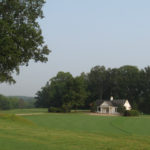











































































































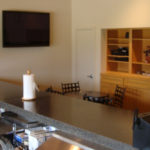







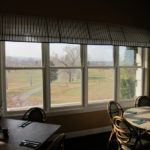






























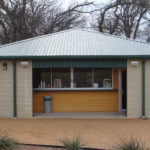

































































































































































































































































































































































































































































































































































































































































































































































































































































































































































































































































































































































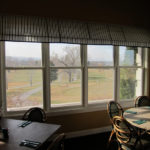













































































































































Tell Us What You Think!
You must be logged in to post a comment.